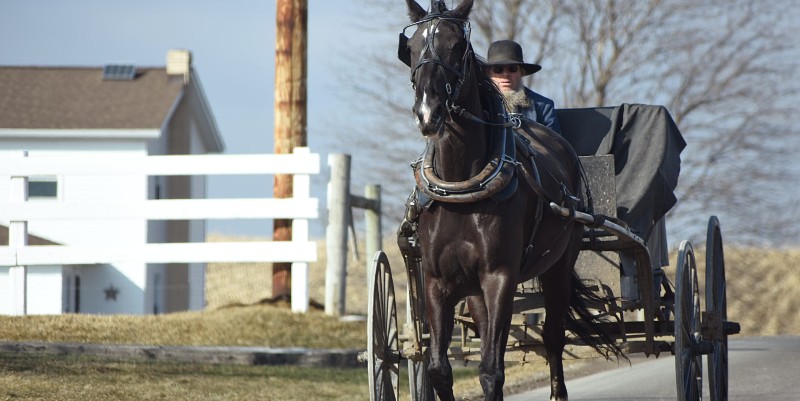You’ve seen the Amish culture in books, movies and even in exaggerated “reality shows.” Without electricity, automobiles, TV, radio or other modern conveniences, the Amish drive horse drawn buggies, use kerosene and candle light, and generally live a rural farming lifestyle. It’s like stepping back in time with a community of people who choose a simple existence and reject any outside influences on their self-described Plain way of life. The Amish have attracted a lot of attention from curious tourists and authors alike. Not only are people curious about this peculiar culture, but it gives a wonderful setting for murder mysteries with a tight-knit community that will protect its own. But how does a community maintain such a unique way of life for hundreds of years without being influenced by the rest of society around them?
The Amish use the analogy of a fence. The Amish community, their families, and their way of life are all inside the fence. When someone leaves the Amish way of life, it is called “jumping the fence.” They have left the protection of the community and gone to live like the non-Amish outsiders. While non-Amish people can look over that fence and observe their unique way of life, they are not permitted in close enough to influence them. There is a careful balance struck between the tourists whose interest and curiosity help the Amish to make a living and the private Amish life that is lived within the community.
But what keeps outsiders out and insiders in?
Language
Language is one rung of that fence. The Amish speak a German dialect called Pennsylvania Dutch, and it is the first language an Amish person learns at home. Small children don’t understand English and often don’t start learning English until they go to school. When Amish people speak to each other, it is in their mother tongue. Outsiders don’t understand the conversations, and it helps to keep insiders insulated against outside friendships and influences.
Conformity
Staying very alike in dress, attitude and behavior is another way to keep people united. Amish communities have a deep belief in being non-prideful. That covers a lot of ground for the Amish, but the bedrock is that everyone is of equal value, and they do not want to set themselves apart or try to puff themselves up. The women all wear a cape dress, which is a certain style of dress that the women sew for themselves at home. Certain colors are permitted, depending on the community, but no prints. The women all wear the same head covering over a tight bun called a kapp, and the same style of apron over their dresses. The women do not cut their hair.
The men all dress the same as well with the same colors of shirts to choose from, the same style of pants, and suspenders that complete their outfit. They also wear the same straw or felt hat and have their hair cut in the same style. When a man marries, he grows an Amish-styled beard, so that the men have the same sort of appearance, just like the women do.
Houses are all built in similar style, and even the buggies they drive are all made in the same style with the same colors, as well, so that no one stands out in the community. Conformity shows a humble attitude, and a desire to blend in, maintain their uniqueness, and cooperate.
Family ties
Family ties work to hold people together in one community. The Amish life centers around the nuclear family. A mother, father, and their children are both the bedrock of the community, and the ultimate goal for every young person. Children work alongside their parents learning the skills they need to live off the land. The boys work with fathers doing the outside work with the animals and crops, and the girls work with their mothers learning to cook, bake, clean, sew and do handcrafts. Of course, there are times when the girls and women are helping with the outside work as well, but the Amish tend to keep very strict gender roles. Grandparents will live with their children’s families and are a treasured addition to the family unit.
With a close, loving family unit that works together, plays together, and worships together, the family ties are very strong. Amish young people are all given the choice to stay in the community or leave for a regular North American lifestyle, and most of them choose to stay. Their friends, grandparents, aunts and uncles, cousins, parents and siblings are all part of the Amish world. Why would they walk away from every relationship that matters to them? If they do choose to leave, it is a very traumatic experience.
Rules
In order to enforce the ideals and unique lifestyle, the Amish follow a strict set of rules called the Ordnung. The Ordnung sets out all of the requirements for Amish life, and most of these are at odds with regular North American habits. It sets out how they are to dress, how their buggies are to look, what conveniences they are permitted, such as a generator to run a heater in the barn, or if they are permitted to use a cell phone for business purposes.
Once a young person chooses to be baptized into the church, they are then expected to follow those rules. If someone flouts the rules, there are some strict consequences, up to an including shunning. That is when the entire community turns their back on a person until they repent of their transgression and come back into compliance with the community’s rules.
The rules are strict, but they also reinforce a strong sense of community an uniqueness. When one is in good standing with the community, there is warmth, assistance in time of need, close friendships and a sense of belonging. These rules unite the community together in their behavior as well as their way of seeing themselves. The Amish are different, and they want to maintain their unique ways without outside influence. And they succeed! The fence holds the community together, and protects them.
In Amish mysteries, we explore what happens when someone inside the Amish community is murdered. With that tight sense of community and those strong, protective ideals, who might be willing to kill, and why? And how far will the community go to either protect its own, or find the culprit?
The Amish try to deal with all discipline at a community level. They do not call in police support for anything except the direst situations. And a murder counts as dire. So when a detective steps into this Amish community, he or she is dropped into a completely foreign culture. How can they navigate all those cultural differences without an Amish culture interpreter?
It’s the perfect setup for a cozy mystery, isn’t it? With a setting filled with cozy comforts like delicious Amish food, the picturesque family-focused community, and an old-fashioned dedication to a Plain, simple lifestyle without modern conveniences, the reader is drawn into a completely different world. Here, rule-breakers might be thrown from the bosom of the community and shunned, but a murderer might still linger in their midst.
***


















